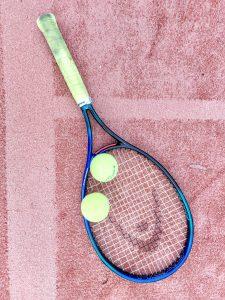We may earn money or products from the companies mentioned in this post.
Understanding the Basics of a Tennis Scoreboard

When watching a tennis match, you may find yourself intrigued by the numbers displayed on the scoreboard To fully appreciate the game, it’s essential to understand how these scores are calculated and what they mean Let’s dive into the world of tennis scoring
Knowing the point system in tennis
In tennis, points are not counted in a traditional numerical sequence like 1, 2, 3, and so on Instead, unique terms are used to represent each score The first point is called “Love,” which signifies zero As play progresses, players earn points: 15 for their first point won, followed by 30 and then 40
Fun fact:
Ever wonder why there’s no score of “45”? It seems that long ago when tennis was evolving from its origins as a medieval game called jeu de paume, players would use old-fashioned clocks with hands that moved in quarter-hour increments – hence stopping at “40”
An interesting twist occurs when both players reach a score of 40; this is called “Deuce” At deuce, one player must win two consecutive points to secure the game If Player A wins one point after Deuce, they gain an “Advantage” However, if Player B wins the next point after Deuce instead of Player A holding advantage outright again reverts back to Deuce
Familiarizing with tennis terms
Tennis has its own unique terminology that adds flavor and excitement to matches Understanding key terms will enhance your enjoyment of the game
-
Service Game:
In tennis matches, each player takes turns serving the ball over the net The server aims to start the point with an advantage, while the receiver tries to return the serve effectively -
Break Points:
A break point occurs when the receiver has a chance to win the game while their opponent is serving It’s a crucial moment that can shift the momentum of the match -
Set and Match Wins:
In tennis, matches are divided into sets To win a set, a player must be the first to reach six games with at least a two-game advantage over their opponent The entire match consists of winning either two out of three sets or three out of five sets, depending on the tournament rules
Tennis scoring may seem complex at first glance, but once you grasp its nuances, it becomes an exciting part of following and enjoying the sport So next time you find yourself watching a tennis match, keep an eye on that scoreboard and appreciate just how much those numbers truly mean
Decoding the Tennis Scoreboard Layout
When it comes to watching a tennis match, understanding the scoreboard layout can sometimes feel like deciphering a secret code But fear not! In this article, we’ll unravel the mysteries of the tennis scoreboard and shed light on its different formats Let’s dive in!
Vertical Scoreboard Format
In the vertical scoreboard format, player names are typically positioned at either the top or bottom of the board This allows spectators to easily identify who is competing in the match It sets the stage for an exciting battle between two skilled athletes
Sets won by each player are displayed horizontally on the scoreboard This gives viewers a quick overview of how well each player is performing throughout the match It’s like a visual roadmap that shows who’s leading and who needs to step up their game
But what about those intense back-and-forth rallies within each game? Well, fear not! The points won by each player in every game are stacked vertically underneath the set scores This allows spectators to keep track of which player is dominating each individual game, adding an extra layer of excitement and suspense
Horizontal Scoreboard Format
If you’ve ever watched a tennis match from a different angle, you might have come across a horizontal scoreboard format In this layout, player names are positioned on either side of the board – left or right – creating a balanced visual experience for viewers
The sets won by each player take center stage in this format as they are displayed vertically below their respective names This arrangement keeps spectators informed about how many sets each player has secured throughout the match, providing crucial context for understanding who has more momentum
Now let’s talk points! In this horizontal layout, points scored within each game are neatly organized within columns adjacent to the set scores This arrangement allows viewers to easily follow the progression of each game and witness those thrilling moments when players battle it out for every point
So there you have it – a breakdown of both the vertical and horizontal scoreboard formats commonly used in tennis matches No longer will you be left scratching your head, wondering what all those numbers mean With this knowledge in hand, you can now fully immerse yourself in the excitement and drama of watching a tennis match!
Interpreting Tiebreak Scoring on a Tennis Scoreboard

Have you ever found yourself puzzled by the numbers displayed on a tennis scoreboard during a tiebreak? Fear not, as I’m here to shed some light on this intriguing aspect of the game A tiebreak is a unique scoring system used in tennis when both players reach six games in a set It provides an exciting way to determine the winner of that set, ensuring that every point counts
Definition of a Tiebreak in Tennis
When the score reaches 6-6 in a set, it’s time for a tiebreak The first player to win seven points, with an advantage of at least two points, emerges victorious This means that if both players are tied at six points each, they must continue playing until one player manages to secure a two-point lead
Reading Tiebreak Scores on the Scoreboard
If you look closely at the scoreboard during a tiebreak, you’ll notice separate numbers displayed after the regular set score These numbers represent the score specifically for the tiebreak Let’s take an example: if you see 7-6(5) on the scoreboard, it indicates that one player has won the tiebreak with a score of 7-6 and had five points to spare
The number inside parentheses represents how many points were needed by the winning player to secure victory in the tiebreak In this case, they only needed five out of seven possible points to come out on top
Understanding these scores helps add another layer of excitement and suspense while watching tennis matches It allows spectators and fans alike to follow along and gauge how close or competitive each tiebreak is
So next time you find yourself engrossed in an intense match and come across a tiebreak on the scoreboard, remember to pay attention to those separate numbers They hold the key to understanding who will ultimately win that crucial set
Common Questions about Reading Tennis Scoreboards

When you’re watching a tennis match, it’s important to be able to read and understand the information displayed on the scoreboard This allows you to keep track of the game progress and know which player is in control However, certain aspects of scoreboards can sometimes be confusing or unclear Let’s address some common questions that arise when it comes to reading tennis scoreboards
How do you determine who is serving?
One of the crucial pieces of information displayed on a tennis scoreboard is which player has the serve at any given time To determine this, pay close attention to the service indicators on the scoreboard These indicators are often represented by dots or triangles next to each player’s name or score
For example, if Player A has a dot next to their name while Player B does not, it means that Player A is currently serving On some scoreboards, these indicators may change after every game or set, so make sure to keep an eye out for any updates
What if there’s no tiebreak score shown?
In tennis matches, tiebreaks are used to decide tied sets when players reach a certain number of games (usually 6) each However, not all tournaments display tiebreak scores on their scoreboards explicitly
In such cases, it’s important to understand that some tournaments use different rules for deciding tied sets called “Advantage sets” In an Advantage set format, players continue playing until one player gains a two-game lead over their opponent
This means that even if there isn’t a specific tiebreak score shown on the scoreboard, you can still determine who is leading in a tied set by keeping track of how many games each player has won and whether one player has a two-game advantage over the other
By familiarizing yourself with these common questions and understanding how to interpret tennis scoreboards, you’ll be able to follow the game more effectively and fully immerse yourself in the excitement of each match
Useful Links

19 how to read tennis scoreboard Quick Guide
How to Read Tennis Scores? Complete Guide
How to Keep Score in Tennis
Tennis Scoring Simplified | Point System + How To Keep …
Tennis Scoring System Explained, Understand Tennis Scores
How To Score In Tennis
How Does Tennis Score Work? | Tennis Score Explained
Tennis
Tennis Score Tube – Vermont Sports
Tennis Score Keeper – $5 Shipping + Reward Points
ATP Scoreboard – Tennis – – NYTimes.com
Tennis Score Tube
Why are tennis points 15, 30 and 40? Scoring system …
Tennis.com | Tennis Live Scores, News, Videos, Player …
Tennis scoring explained
TENNIS INFO (scoring, court size, Grips)
Tennis Post Scoreboard | Net World Sports
ScoreBand tennis score keeping watch review






